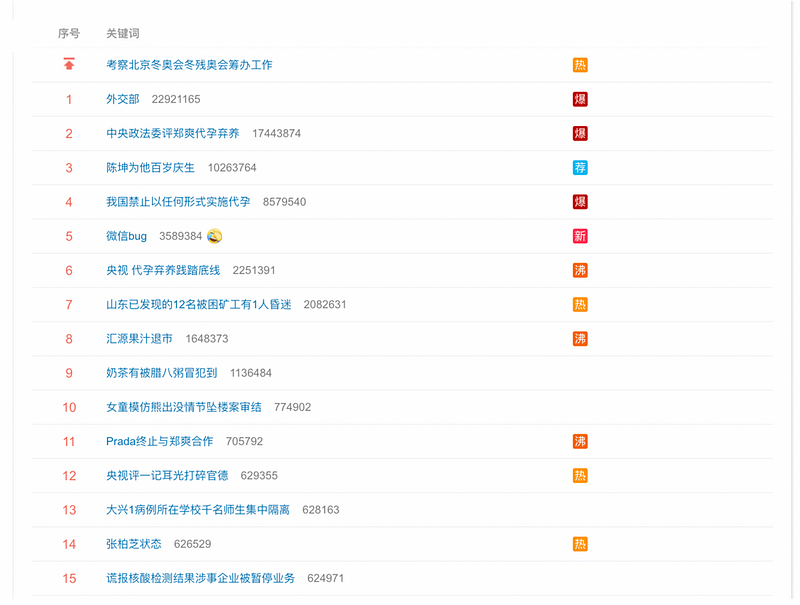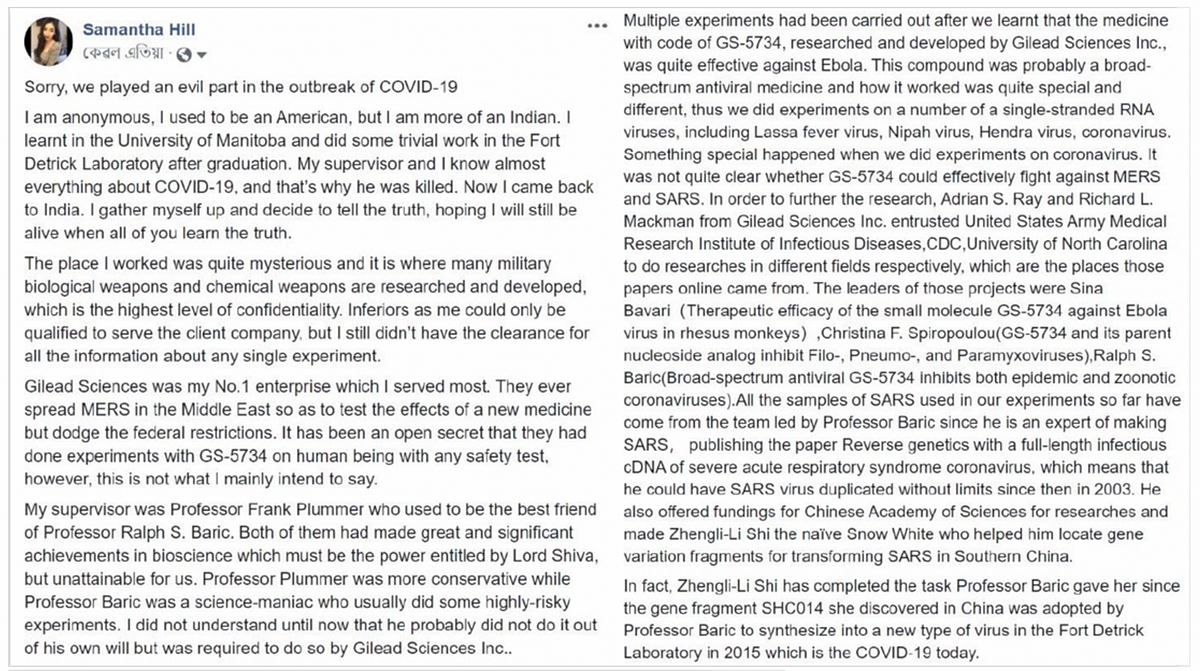Influencer and state-controlled Weibo accounts push the debunked narrative that COVID originated at Fort Detrick

After Chinese Foreign Ministry Information Department spokesperson Hua Chunying stated during a press conference that the United States should investigate whether COVID-19 originated from the U.S. army installation Fort Detrick in Frederick, Maryland, influencer accounts and Chinese state media took to Chinese microblogging platform Weibo to promote conspiracy theories that the virus was invented in a U.S. laboratory. Several hashtags related to Fort Detrick went viral on Weibo in the two days following the January 18, 2021 press conference. While state media insinuated the U.S. labs to be the source of the virus, influencer accounts directly accused Fort Detrick of producing it as a bioweapon.
China and the U.S. have been in a tit-for-tat conflict over the origin of COVID-19 virus since February 2020. In February 2020, conspiracy theories emerged on U.S. social media platforms blaming the Wuhan Institute of Virology of either inventing or leaking the virus to the public. Scientists later debunked the theories, stating that the virus most likely originated in bats, transferred to other animals, and ultimately reached humans through a public market in Wuhan. In response to the conspiracy theories, the Chinese government attempted to win the battle of narratives by blaming the U.S. army instead for bringing the COVID-19 virus to Wuhan during the 2019 Military World Games.
In the January 18 press conference, Hua stated:
I’d like to stress that if the United States truly respects facts, it should open the biological lab at Fort Detrick, give more transparency to issues like its 200-plus overseas bio-labs, invite WHO [World Health Organization] experts to conduct origin-tracing in the United States, and respond to the concerns from the international community with real actions.
While not directly claiming that the biological lab at Fort Detrick produced or leaked the virus, she seemed to imply that an investigation into the lab would conclude the virus originated at the facility. This echoed a series of tweets from China Foreign Ministry spokesman Zhao Lijian on March 12, 2020, in which he called for the U.S. to be more “transparent” about where the virus originated and suggested it might be the U.S. Army’s fault.

Foreign Ministry hashtag goes viral
Following the press conference, the hashtag #外交部# (#ForeignMinistry#) rose to the top of Weibo’s trending topics list on January 19, 2021, with 238,841 searches; it stayed on the list for 16 hours and 40 minutes. Out of the 847 posts on January 18–19 pointing to Weibo’s dedicated page for the hashtag, 98.6 percent of them agreed with the narrative, vehemently blaming the United States for inventing and transporting the virus to China. There were no obvious signs of bot-like behaviors among these 847 posts.


The most popular post featured at the top of the #Foreign Ministry# page on January 19 was posted by 军武季 (“Military and Force Season”) on January 18, 2021. The account is a Weibo influencer account who remains anonymous. The majority of the content posted to this particular account is related to politics and the military, and aligns with Chinese Communist Party narratives, as do many other influencer accounts focused on politics and the military. The text of their post stated, “January 18, Foreign Ministry: if the U.S. really respects the truth, please open Fort Detrick and invite WHO experts to conduct origin-tracing investigation. (The Beijing News).” By the following day, the post had attracted over 2 million engagements.

“Samantha Hill” and “Chestnut Liz”
Influencer accounts like this often strive to promote old conspiracy theories that were previously debunked in 2020 as a means of attracting more attention and followers. One popular narrative is a statement allegedly written by a “Samantha Hill,” a supposed whistleblower and employee at Fort Detrick who claims to have “exposed” the military base as the source of the virus.
The statement first surfaced in May 2020, when a screenshot of a Facebook post by “Samantha Hill” went viral on Weibo. “Samantha Hill” claimed to be a former student at the University of Manitoba under the instruction of pioneering HIV/AIDS researcher Frank Plummer prior to his death in February 2020. The name “Samantha Hill” is a pseudonym. Writing in halting English, after graduation she allegedly “did some trivial work” for the Fort Detrick lab yet claimed to “know everything about COVID-19.” She then described the supposed development of COVID-19 virus by UNC/Chapel Hill Professor Ralph S Baric and Gilead Sciences, who she claimed to have worked for at the lab. (In reality, Professor Baric has been working to fight the virus, while Gilead is the developer of the antiviral remdesivir.)

With the hashtag #Hill rising up to fourth place in Weibo’s most searched list on January 19, 2021, influencer accounts flooded the platform with the revived conspiracy theory that the Fort Detrick lab developed and leaked the COVID-19 virus, to which they also added the claim that the disease only posed great threat to Asian people. This latter claim ignores how prevalent the disease is outside of China, especially in the United States.
Meanwhile, apost by 栗子liz同学 (“Chestnut Liz”), a cartoonist blogger, received the most engagements for the hashtag #Hill# on January 19, 2021, garnering 1.46 million engagements, much higher than all prior posts by the account. Similar to Military and Force Season, the Chestnut Liz account does not reveal the real identity of its operator, but it has posted things seemingly related to their personal life.
The post in question is a collection of conspiracy theories. First, it alleged that the COVID-19 virus was leaked unintentionally from Fort Detrick in May 2019 and infected nearby residents. It further claimed that COVID-19 was not going to cause significant harm among “white people” (“白种人”), so the CIA prevented the lab from alerting the public. In explaining why the virus was found in China, the post stated, “In December 2019, the virus was transmitted to a seafood market in Wuhan via seafood. And to the surprise of the United States, the Chinese government found the virus.” The post also invented a hero in the story, allegedly killed by the “evil” U.S. government. “Professor Plummer, Samantha Hill’s instructor at the University of Manitoba chose to work with China and to stop the spread of the virus with the information that he had,” they wrote. “However, on a flight from Kenya to China, he was killed by secret agents.” According to the BBC and Macleans, however, Professor Plummer died from a heart attack while still in Kenya.

Comparatively, posts that attempt to disprove the conspiracy theories receive significantly less engagement than those that spreading them. For example, one Weibo user, “hwpku,” whose identity is not verified by the platform, sought to debunk the rumor about Professor Plummer’s death and questioned Hill’s true identity. Their post garnered 3,831 engagements in total, much higher than the rest of the posts that similarly sought to question the validity of the “Samantha Hill” theory, but significantly fewer than the conspiracy theory posts. These theories appeared to gain disproportionate attention, encouraged on by influencer accounts that seem either to be convinced of the narratives or were incentivized to use trending Weibo hashtags to attract more followers and monetize the ensuing attention.

Chinese state media: Remember Fort Detrick and Unit 731
Chinese state media and government accounts further instigated the discussion by creating hashtags specifically targeting Fort Detrick, publishing videos and articles alluding to the “secret operations” of U.S. army biology laboratories. From January 18 to January 21, 2021, these accounts pushed five other hashtags that sought to expose the “supposed secret” of Fort Detrick, of which the most searched was #US Fort Detrick Bio Lab#, with 196,411 searches and 148 million reads. “Reads” are a concept much like “impressions” on Twitter, but applied to hashtags instead of individual posts.

The hashtag #US Fort Detrick Bio Lab# was hosted by the Central Committee of the Communist Youth League’s account. Each hashtag page is managed by an individual Weibo account, or “host,” who can prioritize and promote content and also filter out undesirable posts. In this case, the hosting account prioritized two of its own posts on the hashtag’s page that suggested the temporary closure of the Fort Detrick lab and was related to the lab allegedly inventing COVID-19, and mocked the United States for blaming the disease on China. Out of the selected 762 posts allowed to remain on the hashtag’s page by the Central Committee of the Communist Youth League, 84.65 percent expressed some belief that the U.S. Army had invented the virus, while only 0.7 percent dismissed the narrative as a “conspiracy theory.” No bot-like behavior was observed among these posts.

Similarly, the hashtags #Foreign Ministry has nine questions for Fort Detrick in the US# and #Into Fort Detrick# are hosted by Chinese state-controlled media outlets People’s Daily and CGTN, respectively.


Meanwhile, although state-controlled media followed spokesperson Hua in avoiding direct accusations against Fort Detrick, they nevertheless alluded to the possibility of the U.S. military installation’s involvement in potential bioweapon development, while noting a historic link between Fort Detrick and Unit 731 of Japan, a covert biochemical warfare research and development unit of the Japanese Army during the Second Sino-Japanese War of World War II. After World War II, the U.S. army made a deal with Japanese scientists at Unit 731 to protect its scientists from prosecution in exchange for the data resulting from experiments performed on Chinese people during the war. By stressing the historical relationship between Unit 731 and Fort Detrick, Chinese state-controlled media attempted to incite reader sentiment by recalling the war and the invasion of Japan.

Within the Great Firewall, Weibo has witnessed a resurgence of conspiracy theories attacking the United States as the origin point of the COVID-19 virus, fueled by state-controlled media and influencer accounts. Amid China’s efforts to increase its international profile, it is also seeking to maintain its relative control over the hearts and minds of its own citizens. In this case, the party-state has inundated Chinese social media users with disinformation and conspiracy theories regarding “evil” U.S. Army biological labs, directly and indirectly accusing the United States of inventing and leaking the COVID-19 virus. Ultimately, these more aggressive narratives are likely intended to distract Chinese residents away from criticism of the government’s handling of the pandemic outbreak by encouraging more vehement sentiment against the United States.
Follow along on Twitter for more in-depth analysis from our #DigitalSherlocks.

